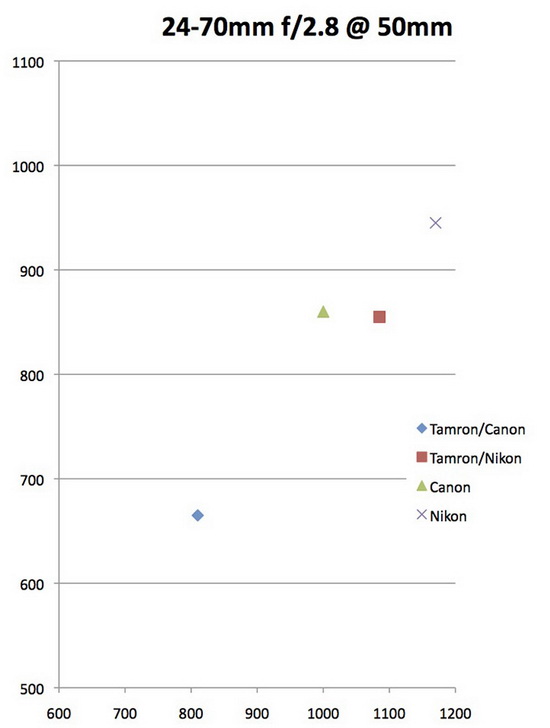Featured Products
Roger Cicala put several 24-70mm camera kits under testing, in order to find out which one is the best. Though the end results were not surprising, the test gives important details to photographers looking to buy new gear.
One of the most trusted photography-related people on the web, Roger Cicala, is looking to purchase a personal camera kit. He is the founder of LensRentals.com, a website which allows photographers to rent digital imaging equipment. Deciding over a new camera system for himself is not easy, but the first step is to compare resolutions of two of the best cameras and three of the best 24-70mm lenses available on the market.

Canon 5D Mark III vs Nikon D800E 24-70mm systems
The perfect camera system does not exist
In Cicala’s vision, the perfect camera would consist of the Nikon D800E sensor, Canon 5D Mark III autofocus, the WiFi function in Canon 6D, the touchscreen of the Canon T4i, a Nikon flash system, and the user interface of a Pentax shooter. The shortcut would be to buy a camera and all lenses made for a single camera, however, since he is on a limited budget, he will have to make several compromises.
The first step is to compare resolutions and most people would think that with the help of Imatest or DxOMark information, it would be very easy to determine which is the best camera and which is the best lens. However, the photographer said that lenses do not perform the same way on different cameras, therefore he decided to test two systems from two different manufacturers and a lens from an independent company, like Tamron.
24-70mm comparison: Canon 24-70 f/2.8L II, Nikon 24-70 f/2.8 and Tamron 24-70 f/2.8 VC
Roger confirmed that the most used lens in his photo shoots is the 24-70mm f/2.8, therefore he decided to test the Canon 24-70 f/2.8L II on the 5D Mark III, the Nikon 24-70 f/2.8 on the D800E, and the Tamron 24-70 f/2.8 VC on both cameras.
The most relevant test consists of comparing MTF versus frequency plots at the center of the lenses. All lenses are affected by astigmatism, however, some are more influenced, while some are less influenced by this aberration. The modulation transfer function graphs were studied with the lenses set at 50mm.
The tests showed that the Canon lens has a higher MTF than both Nikon and Tamron products, but this was not surprising at all. Additionally, the Nikon 24-70mm f/2.8 had a slight advantage over the 3rd party lens.
Canon 5D Mark III vs Nikon D800E
When the DSLR cameras entered the fray, the difference between the lenses was much more visible. The tests consisted of 50mm focal length with apertures set at f/2.8 and f/4. The first lens to be put under the microscope was Tamron, which recorded a center MTF50 of 810 and 940 on the 5D Mark III at f/2.8, respectively f/4. On the D800E, it managed 1085 center MTF50, respectively 1225 at f/4 aperture.
The difference is bigger in the center, but it gets a lot smaller when testing in the corners, where the Tamron lens achieved 350, respectively 445 on the Canon camera and 445, respectively 560 on the Nikon shooter.
Now it came the time to test the Canon and Nikon lenses on their respective cameras. Unsurprisingly, the Nikon D800E with a Nikon lens performed better thanks to its superior resolution. Canon’s results are 1000 at f/2.8 and 1060 at f/4, while Nikon’s results for center MTF50 are 1170, respectively 1240.
Once again, the distance between the two lenses narrowed in the corners where the Canon achieved 450 and 505, while the Nikon lens fared slightly better with 505 and 570.
Final test results and conclusion

Tamron / Canon versus Tamron / Nikon versus Canon versus Nikon 24-70mm lens system comparison. Credits: LensRentals.com
The actual resolution comparison can be seen in the graph above, demonstrating there was no major disparity between the systems. The Tamron / Canon kit is the worst, while the best is the Nikon system. There are similar scores for the Canon and Tamron/Nikon systems, but like expected, the Nikon lens on the D800E is the best in terms of resolution.
For the untrained eye, it would be better to display the SQF results. Cicala said that if it were to print a 11 x 16, then anybody could see the distinction between the worst system, Tamron on 5D Mark III, and the best system, Nikon lens on D800E. However, it would be hard to notice any difference between Nikon D800E and 5D Mark III with the superior Canon lens. For that, the Subjective Quality Factor numbers would be useful on a 16 x 20 print size.
Even though the lens is one of the most important aspects of a camera, it depends on which camera is installed. When buying a new camera kit it is very important to think about the price as well. At the moment, the Tamron lens is $600 cheaper than the Nikon lens and $900 less expensive than the Canon lens.
Price wise, Cicala compared the Tamron / Nikon combination with the Canon system. If it were to buy the Tamron lens on the D800E, then it would be $1,000 cheaper than the 5D Mark III with Canon lens. And that is a major decision factor for a person with a limited budget.






































